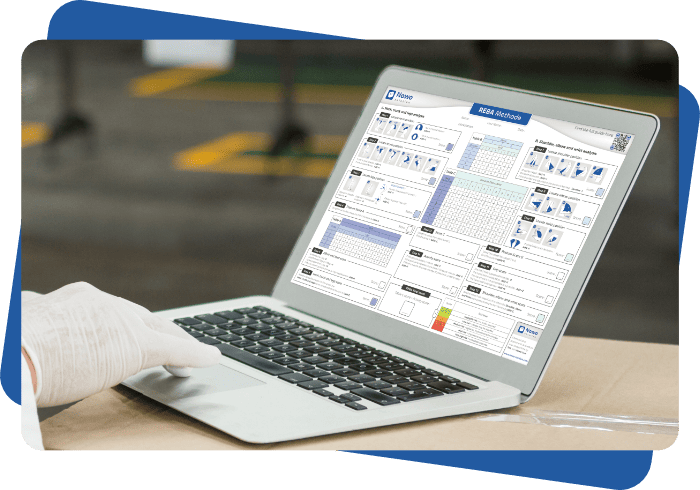The REBA method
The REBA (Rapid Entire Body Assessment) method is an evaluation tool for postural risk assessment of the entire body. It helps quantify biomechanical risks, including uncomfortable postures, repetitive motions, and physical exertion.
Through the REBA method, safety professionals can accurately quantify the level of biomechanical strain experienced by operators, contributing to comprehensive workplace health and safety assessments.

The REBA method (Rapid Entire Body Assessment) assesses different body postures required and difficulty. It assigns a score to each of the following body parts: wrists, forearms, elbows, shoulders, neck, trunk, back, legs, and knees.
The method tables are then used to compile the risk factor variables generating a single score representing the risk level of MSD.
The REBA method uses a scoring system for evaluating postural assessments, encompassing static, dynamic, changing, or unstable positions.
The REBA score provides a postural risk score, allowing for the quantification of posture criticality.
This method is not recommended for evaluating manual handling tasks.
The REBA method examines strengths and activity, but it mainly focuses on work postures.
It does not take into account the duration of the activity, the recovery period, or the vibrations.
It is only designed to assess the right side and the left side of the body separately, and there is no method for combining scores to obtain a result for the whole body.
The combined impact of all activities conducted during a job or task is not considered.
The REBA method does not allow precise evaluation of the tasks linked to small manipulations of objects with the hands.
It does not make it possible to assess tasks requiring long travel or very varied and unpredictable tasks.
This method lacks precision in analysing the frequency of efforts or certain postures very specific to production.
Analysis of the request and development of the criteria for choosing the work situations to be observed.
Assessment of critical postures using RULA-type postural assessment methods to estimate their risk levels.
Analysis of the postural data making it possible to draw up the list of priorities and to seek solutions and proposals for improvement.
Formulation of improvements based on the results of the analysis and implementation of corrective measures taking into account the identified risks.
A new assessment of the workstation makes it possible to study the impact, and benefits, of the corrective measures on the postural risk.
Nawo Live is your physical activity risk assessment tool for identifying risk factors for musculoskeletal disorders (MSDs).
In Nawo Live, automate and evaluate all biomechanical risk factors using reference methods (RULA, REBA, NIOSH, etc.).
Nawo Live guarantees you a reliability of the measurements acquired by our systems, including :
Newsletter